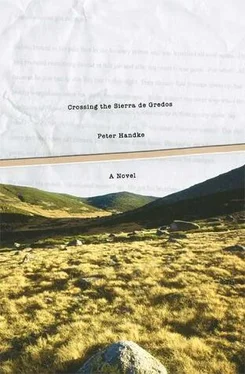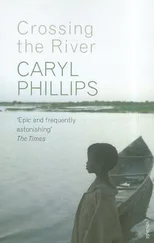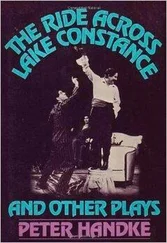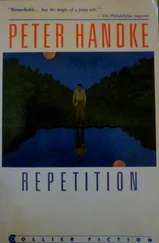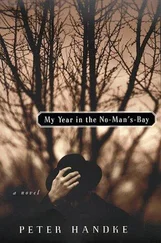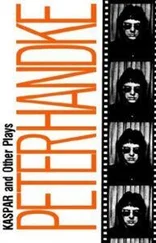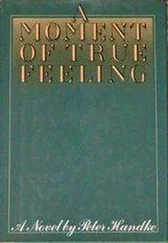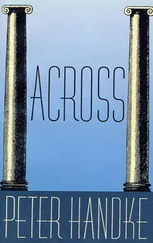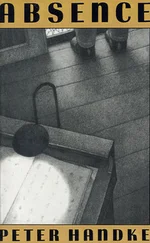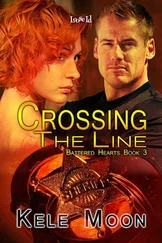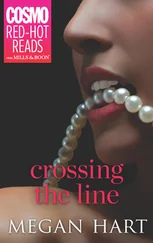Even now, long after the fact, when she spoke of it, the word was present for her as hardly any present could be. Although she kept the word secret, she revealed herself terrifyingly to the author. If he was terrified, it was in this sense: suddenly he viewed her with different eyes; he no longer recognized in her what he thought he knew; he saw before him a total stranger, and at the same time someone familiar; he wanted both to back away and move closer; his terror: not so far from what was at one time called “holy,” at least with a hint of it. And yet she remained unapproachable? Or on the contrary? And he, or one, or whoever, simply did not find the right way to approach her?
After the arrival of that word image—“It flew to me, came sailing to me”—she had driven on at her steady speed. She drove on. She is driving. The highway over the upland plateau is bumpy, and the car bounces and sways like a carriage. While driving she pushes back the Santana’s canvas top. She sticks something between her lips, something that suits her even less than a cigarette: a toothpick, and not even one made of ivory, let’s say, but a wooden one. She takes off her hat and lets down her hair — which does not suit her either, or does it now?
Empty blue sky, devoid of airplanes, devoid of the kites and buzzards so common on the mesa, with that motionless dark cloud still hanging there, though by now low on the horizon, sinking out of sight, like a mountain. In her open rough-terrain vehicle the heroine shows herself to the author for a moment from high above (although he has never written a film script). Then she moves in close again, in a veritable close-up, or a torso shot. And for the first time now he sees her eyes, as if they had always been veiled to him previously, even though he has been preoccupied with her story for so long, including their color, which again does not seem to suit her at all; or perhaps it does, and how! though not her origin and her country, but then what did that have to do with her story?: an indescribable black.
“Indescribable”? How could he, such an experienced writer, let a word like that slip out? And now he tried at least to describe that black, at first mainly for himself, as usual: it was a black that could resist any light, even the most glaring, even the winter sun hanging low over the fallow disk of the earth. The adventurer’s eyes did not merely face down the sun; they literally absorbed it — perhaps, too, because although they were open wide, they did not dry out, at all, at all — and sent the rays back, transformed, and how! A black like the black of the eyes of the white-robed angel on the medallion, whose one finger pointed sideways toward the empty tomb? No! How extinguished those eyes appeared now, almost wondrously extinguished; for how they would flare up again when—. In ancient books, the word for the black of her eyes was gagat or azabache , meaning something like pitch black. But not that either: this was no film. After all, hadn’t the movies made it impossible to find a color and a face? These were supplied ready-made, in close-up? Besides, our heroine bore no resemblance to any angel, including the fallen ones, and least of all at such moments! This black sucked in the light, absorbed it; tasted it; savored the aftertaste. Her entire face, then her neck and shoulders as well, were engaged in silent tasting, motionless, without biting, chewing, or swallowing. Along with the light of day, the air was tasted, the airstream, the hues of sky and earth. And also striking to the author — which subsequently struck him again and again, if anything at all — was how, in addition to her eyes, all the parts of the woman’s body, even the smallest ones, unveiled and unclothed, revealed themselves in the light surrounding her; as aspects of the light, stretching, billowing, arching, even when the woman did not raise her face as she drove along, but rather kept it lowered. Visible even now the seemingly eternal abrasion on her brow, always in the same place. Visible, too, her hardworking villager’s hands: she was strong. But the physical strength was not her own. And nonetheless the many scars on her body.
And how the author will stare when these patches of light he is contemplating on the woman’s body are suddenly joined by one that is considerably more extensive — that is, when a few milestones after the arrival of the aforementioned word image, one of her shoulders, again seen from above, is suddenly bared, her shirt having seemingly slipped down to her elbow of its own accord? And although the bunched material perhaps interfered with her steering, she did not pull the shirt back up. She drove on quite some distance with one shoulder bare. Her skin reflected the light. The lashes above her black eyes stuck out distinctly, without mascara, ever more distinctly, like the acacia thorns from the windshield. And finally she bit the toothpick in two.
“But even this image or word,” she indicated to the author later on, “had a black mourning border. It arrived as pure energy and was accompanied by impossibility. The more insistently it called for unity, the stronger was the echo, and that proclaimed: separation, once and for all! Not mere mourning: pain, almost screaming; pain at the impossibility of staying together forever. So then I tossed the falcon’s wing, picked up in the devastated forest after the hurricane, out the roof of the car.”
And here the moment has come in her story to indicate that, according to tradition, her clan does not belong only to the Sorbian, i.e., Slavic, minority in the easternmost reaches of Germany. More notably it descends from a minority within this minority: from an Arab trader who came to the region even before the turn of the first millennium and conducted his business there. Hence her vanished daughter’s Arabic book? Hence the blackness of her eyes?
Myriads of images, constantly brushing past her, plummeting down on her, shooting up inside her, shining through her, tickling her awake during that solitary drive. As much internal as external, high above as down low, horizontal as vertical. And each of the images, even if it was switched off after a microsecond and at most had a bit of an afterglow, was tangible, and accessible to both the senses and the mind, both leaving an aftertaste and clarifying one’s thought processes; was each image, albeit surrounded, as now, and undergirded by the glow of missed continuity, a treasure that would never be lost, even if one allowed a particular image to disappear again without making a point of tasting and contemplating it, and a treasure whose value — she of course knew all about “value”—exceeded anything one could ever “have” in life or call “one’s own”; the fundamentals underlying any “goods”?: “love” (was love a good?), “loyalty,” including to oneself (was loyalty a good?), “beauty,” and “goodness” (was goodness a good?), “renunciation” (was renunciation a good?), and of course “peace”?
At any rate, each image among the thousands was under the control of its receiver, even if it had flashed by in the twinkling of an eye, as if the receiver were also the transmitter. What remained of the image was the imprint, which, before it faded, sooner or later, and in some cases not at all (in this respect comparable to an unusual dream), could “bear fruit,” and this without exception (whereas with dreams this was the exception). And one could decide which of these images would bear fruit — as the selection and utilization of those just described rested on the intensely personal choice made by the one “image person” in question.
“Those images,” she dictated, for the moment more a “banquière” than an “aventurière,” to the author, “are a form of capital. Capital without any exchange value, but with all the more use value. Capital whose owner one remains only if one chooses to use it to the utmost. If one allows this capital to sit unused, it collapses, and — this is the unique feature of these moveable and/or immoveable image assets, my most liquid holdings and at the same time my soundest real estate — one collapses with it, even if the opposite appears to be true. Having and owning as a process of constant trading, yet not speculating and lining one’s pockets but rather pure usufruct, as much to one’s own benefit as to others’. By putting the image-capital to work, and why shouldn’t one? for profit and enrichment, shared profit and joint enrichment, without claiming to be an owner, without the title of ownership: a way of handling property that has hitherto gone unrealized in any economic and banking system—” She broke off; end of dictation. But had the author taken it all down? His scribbles indecipherable; his private shorthand.
Читать дальше
